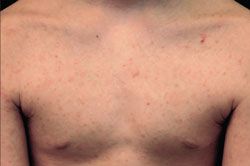Persistent Papular Eruption: What's Your Dx?
Pityriasis rosea had been diagnosed in this 10-year-old boy 3 months earlier. However, the condition had not resolved within that time as had been predicted. In addition, the patient’s parents noted that pictures of pityriasis rosea that they had found on the Internet did not resemble their child’s skin.

Case: Pityriasis rosea had been diagnosed in this 10-year-old boy 3 months earlier. However, the condition had not resolved within that time as had been predicted. In addition, the patient’s parents noted that pictures of pityriasis rosea that they had found on the Internet did not resemble their child’s skin.
What is the correct diagnosis?
(Answer on next page)
Pityriasis lichenoides (PL) is a benign lymphoproliferative disorder of the skin that can take 1 of 2

morphologically and histologically distinct forms:
•An acute form (pityriasis lichenoides et varioliformis acuta [PLEVA]).
•A chronic form (pityriasis lichenoides chronica [PLC]).
In most instances the entities are distinct, but overlap does occur.
This child suffers from the chronic form. PLC usually develops in the first decade of life as an indolent process characterized by a generalized papulosquamous eruption. The eruption takes the form of recurrent crops of multiple small red to red-brown papules that are often surmounted by a platelike scale. Mild itching may be present. When individual lesions resolve, postinflammatory hypopigmented macules without scarring often remain.
Pathophysiology
PL is part of a spectrum of cutaneous disease that results from a proliferation of lymphocytes in the skin. These lymphocytes range from those that are benign (as in PL,in which there is a preponderance of CD4+ lymphocytes in PLC and of CD8+ lymphocytes in PLEVA) to others that are potentially malignant (as in the spectrum of lymphomatoid papulosis, in which CD30+ lymphocytes are present and which is associated with a malignant cutaneous lymphoma). It has been proposed that the proliferation of lymphocytes in these skin diseases is a reaction to a viral pathogen, since many affected children have had a preceding viral illness.
Diagnosis. I generally perform a biopsy during the first few months in which the condition is present, even if the morphology is typical. Usually this is at the request of the parents: because of the chronicity of the condition, it is reassuring for them (and for the treating clinician) to have histological confirmation of the exact nature of the process. However, the diagnosis can usually be reliably made on clinical grounds.
Treatment. Because therapy often takes months and success is not ensured, treatment of PLC can be very frustrating for parents, children,and clinicians. PLC is unlikely to respond to topical corticosteroids; however, virtually every child with this condition does receive a trial of these.
In my experience, about 50% of affected children treated with systemic antibiotics have significant clearing; nonetheless, complete resolution is unlikely. Erythromycin and tetracycline in antimicrobial doses for 2 months is my standard therapeutic trial (in children of an age at which tetracycline is appropriate). I discontinue the antibiotics if the condition has not cleared in 2 months, and I taper them over the third month if resolution has occurred.
I find that UVB phototherapy is also very beneficial, and if a patient has access to this therapy, I use it either as monotherapy or concurrently with the antibiotics.
Prognosis. PLC may persist for months to years, and it is not unusual for the condition to last 2 to 3 years without change. However, spontaneous resolution is the rule even in patients who have not responded to treatment.
Recognize & Refer: Hemangiomas in pediatrics
July 17th 2019Contemporary Pediatrics sits down exclusively with Sheila Fallon Friedlander, MD, a professor dermatology and pediatrics, to discuss the one key condition for which she believes community pediatricians should be especially aware-hemangiomas.